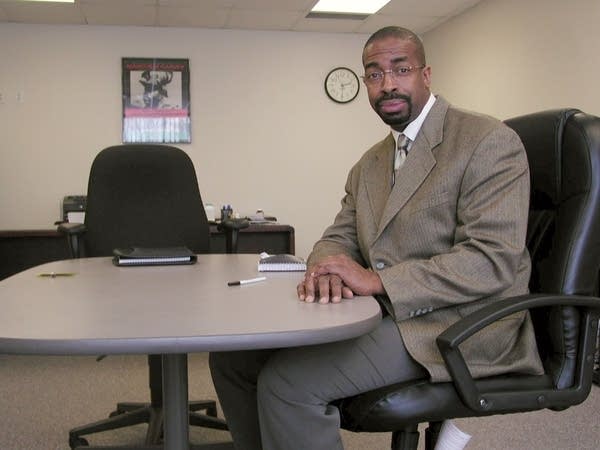Tech college sees future of Minnesota work force in minority students
Go Deeper.
Create an account or log in to save stories.
Like this?
Thanks for liking this story! We have added it to a list of your favorite stories.

Dunwoody College is within sight of celebrating a century of training the backbone of the workforce: machinists, plumbers, printers and auto mechanics. The school has been at it's current site in downtown Minneapolis since 1914.
In one of Dunwoody's shops, student Eric Davis stands beside a powerful machine that spins a blade over a movable platform. Davis hopes to eventually work as a machinist.
He runs his fingers over the smooth surface of a freshly cut block of solid steel.

"It's a v-block and these are 45-degree angles," he explains. "If you need to cut the angle off the corners (of a square block), set it in there and you'll be able to come and plane the ends off where it will be vertically straight."
Turn Up Your Support
MPR News helps you turn down the noise and build shared understanding. Turn up your support for this public resource and keep trusted journalism accessible to all.
As an African-American, Davis also represents the direction Dunwoody hopes to go as it charts its future course. Until two years ago, the school's student body was almost exclusively white and male.
"We've added people of color on board as well as women, now the perception changes. Now the overview changes," said Amondo Dickerson, Dunwoody's director of diversity.
Dickerson has seen the creation of a new student multicultural center and a women's resource room. Since Dickerson started in his position, the percentage of people of color has risen above 20 percent.

"Within the next three four years we want to look around and see students of color and see 30-35 percent," he said. "If I can get 40 percent that'd be great."
Dickerson said reaching and sustaining that goal, though, will require a concerted effort.
That's where Denise Smith's sixth grade class at Seed Academy in north Minneapolis comes in. One afternoon they stand an chant poems by Langston Hughes in unison. The poem's words are an affirmation of African American culture--a culture Dunwoody hopes to welcome.
Dunwoody has begun a partnership with the school and the affiliated Harvest preparatory school to create a pipeline of potential students.
It's hard for them to have a vision for what these professions actually do.
Dunwoody is now in the process of building a new high school, named Dunwoody Academy, in an effort to maintain a continuous relationship between Seed and the college. Seed and Harvest President Eric Mahmoud said the Dunwoody connection offers tangible, longer-term educational and professional goals that his students typically find elusive.
"One of the main challenges of the children we serve--because many of the parents don't have these professions--it's hard for them to have a vision for what these professions actually do," Mahmoud said.
The high school will also offer eight hour school days and a 210-day school year. Mahmoud said by the end of their senior year the students will have completed a total of two years more class time than their public school counterparts. The system expands upon smaller applied learning programs at places like North and Edison High Schools that Mahmoud said appear to help many lower income, African American students.
"Attendance rate (is) higher, grade point (is) higher, graduation rates (are) higher," Mahmoud said. "So we have clear data that a Dunwoody type program works."

Dunwoody Academy is scheduled to open in the fall. Mahmoud and Dunwoody administrators acknowledge not all of the high school's students will want to go on to technical careers such as auto mechanics or air conditioner repair, but they say enough of them could to supply the future workforce the state's economy demands.




